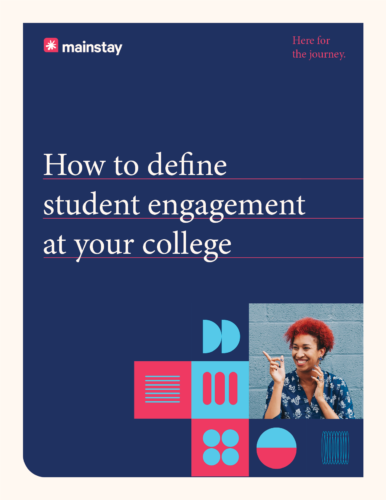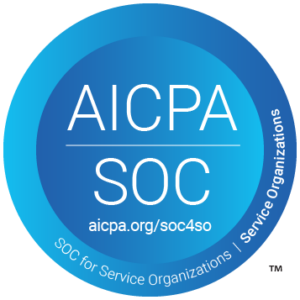Student engagement has been an intensely debated topic among higher education leaders, practitioners, and researchers for years — and rightly so. According to Dr. George Kuh, Chancellor’s Professor Emeritus of Higher Education at Indiana University, “Student engagement is no longer a buzzword. It’s part of the lexicon in higher education.”
Creating your institution’s own definition of student engagement is the first step to establishing an engagement strategy that will yield positive outcomes for your school and your students. As many institutions are asked to achieve greater outcomes with fewer resources, understanding the best ways to engage your students can save you from spending time and money on strategies and tools that don’t align with your student success objectives.
Mainstay’s latest guide, “How to define student engagement at your college,” helps focus conversations about this topic. It includes thought-provoking prompts to help you identify what student engagement really means at your institution. These conversations often inspire many differing viewpoints, so establishing a framework for building your definition can be key to driving productive discussions and creating an actionable plan.
4 questions to help you define student engagement
No two students are the same, and they don’t engage in exactly the same way, either. With a diversity of experiences and backgrounds comes great beauty, opportunities — and challenges. Exploring these four key questions, and using them to start conversations at your institution, can help you construct a definition of student engagement that best serves the needs of your school’s unique cohort of students.
1. What non-academic factors contribute to student engagement?
The real benefit of engagement is equipping students with the tools and skills they need to succeed holistically. Academic achievement is an important piece of the puzzle, but it isn’t necessarily the most important factor for every school. Based on the makeup of your student body and the success metrics that matter most to your school, are there any non-academic elements that could positively impact student engagement?
Attending a football game with classmates or meeting for morning coffee can go a long way in cultivating interpersonal connections and supporting mental health and a sense of belonging for students. Technology can provide similar benefits. For example, many institutions are exploring how behaviorally intelligent chatbots can help expand students’ support networks by checking in with them, listening to their feedback at scale, connecting them with helpful resources — or connecting them with an expert at your school when they need one-on-one support.
According to Kevin Kruger, President of the National Association of Student Personnel Administrators (NASPA), “Socio-emotional needs are not frivolous, nor are connections to other students. Those interactions that actually support student mental health — that’s a dimension that we now know is critically important.”
2. How do background, socioeconomic status, and identity factor into the equation?
Supporting a student’s sense of belonging at college is increasingly important, particularly for historically underrepresented groups. At a time when higher education institutions — and the country as a whole — are in the midst of a renewed reckoning on systemic racism, it’s essential to re-examine how traditional definitions of engagement may not account for a student’s background, socioeconomic status, and identity. Consider how your institution currently evaluates engagement levels across race, finances, and other demographic factors — and use your findings to inform your definition of student engagement.
That’s exactly what Georgia State University did. After evaluating their engagement practices, they found that using behaviorally intelligent chatbots to help students meet key deadlines and complete critical tasks boosted rates of both FAFSA filing and registration for the fall semester by three percentage points. This approach sparked engagement particularly well with first-generation and Pell-receiving students, who sent 9.4% and 31.7% more messages to their bot on average.
3. How can we better understand the relationship between “engagement” and “belonging”?
While engagement and belonging are closely related, they are not the same. Engagement relates to students’ behaviors, while belonging taps into how they’re feeling.
It’s proven that a student’s feelings of belonging can directly influence their academic success, persistence, and well-being. Yet, many students struggle to find their place at college. This can be particularly true for students from low-income backgrounds, first-generation college-goers, and those who are Black, Indigenous, and Latinx.
As you have conversations about the ways your institution can redefine student engagement to support your students of all backgrounds, it’s important to explore the intersection between engagement and belonging. How does one affect the other at your college or university, and how can you accurately measure both metrics?
4. How will we measure student engagement going forward?
Collaboratively landing on a shared definition of what student engagement means at your school is the first step to measuring it and improving outcomes. When you know which metrics you want to track, you can identify your strengths and challenges, and develop a plan for future success.
In the words of Sheenah Hartigan, who leads enrollment services at Ocean County College in New Jersey, “Engagement is qualitative, but you also have to set quantitative goals. Student success is the bottom line. That’s what matters. But the engagement rate affects the success rate.”
For many students, learning how to become, and stay, engaged is an important skill in and of itself. Mastering it helps promote empathy and collaboration with peers, improves their ability to take criticism and feedback from mentors, and helps set the stage for future community involvement. In many cases, engagement is a means to an end — but it can be much more than that. For higher education leaders who understand the true potential of student engagement, successfully preparing students for long-term fulfillment in all aspects of life is the ultimate goal.
Start redefining student engagement at your school

“How to define student engagement at your college” is your handbook for sparking meaningful conversations about this topic with other leaders at your school. Download it for free today to explore the actionable steps you can take to unlock your definition of student engagement based on proven research and key insights from higher education leaders.


